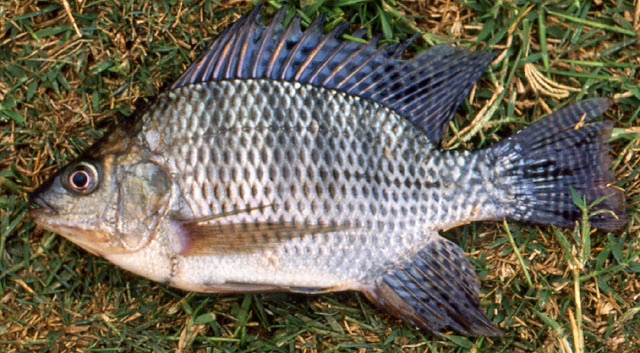| Cichlidae (Cichlids), subfamily: Pseudocrenilabrinae |
| 60 cm SL (male/unsexed); max.weight: 4,324.0 g; max. reported age: 9 years |
|
benthopelagic; depth range 0 - 20 m, potamodromous |
| Africa: naturally occurring in coastal rivers of Israel (Ref. 5166), Nile basin (including lake Albert, Edward and Tana), Jebel Marra, Lake Kivu, Lake Tanganyika, Awash River, various Ethiopian lakes, Omo River system, Lake Turkana, Suguta River and Lake Baringo (Ref. 2). In West Africa natural distribution covers the basins of the Senegal, Gambia, Volta, Niger, Benue and Chad, with introduced specimens reported from various coastal basins (Ref. 53405). Widely introduced for aquaculture, with many existing strains. Several countries report adverse ecological impact after introduction. The following subspecies were previously recognized: Oreochromis niloticus baringoensis, Oreochromis niloticus cancellatus, Oreochromis niloticus eduardianus, Oreochromis niloticus filoa, Oreochromis niloticus niloticus, Oreochromis niloticus sugutae, Oreohromis niloticus tana and Oreohromis niloticus vulcani. |
|
Dorsal spines (total): 15-18; Dorsal soft rays (total): 11-13; Anal spines: 3-3; Anal soft rays: 9-11; Vertebrae: 30-32. Diagnosis: jaws of mature male not greatly enlarged (length of lower jaw 29-37 % of head length); genital papilla of breeding male not tassellated (Ref. 2). Most distinguishing characteristic is the presence of regular vertical stripes throughout depth of caudal fin (Ref. 4967, 53405).
Description: lower pharyngeal bone longer than broad, its anterior part longer than toothed part; outer jaw teeth bicuspid, inner jaw teeth tricuspid, posterior pharyngeal teeth bicuspid and stout; 3-4 rows of teeth in jaws (3-5, rarely 6, in specimens over 200 mm SL); micro-gillrakers present; scales cycloid (Ref. 53405).
Coloration: margin of dorsal fin grey or black; vertical bars in caudal fin 7-12 (Ref. 2). Regular black cross bars on caudal fin; ground colour greyish, relatively dark in adults; back olivaceous-green, sides paler, with 6-9 rather indistinct cross bars; belly whitish; upper lip pale green or white, lower lip white; dorsal and anal fins greyish, sometimes with very narrow red margin, soft part of fin with vertical lines (or with aligned light spots resembling striped pattern); pelvic fins grey, pectorals transparent; "tilapian" spot lacking in adults but very distinct in fingerlings which also have more distinct cross bars and very prominent black spot on upper part of caudal peduncle; throat, belly and unpaired fins black in mature males (Ref. 53405). |
| Occur in a wide variety of freshwater habitats like rivers, lakes, sewage canals and irrigation channels (Ref. 28714). Mainly diurnal. Feed mainly on phytoplankton or benthic algae. Oviparous (Ref. 205). Mouthbrooding by females (Ref. 2). Extended temperature range 8-42 °C, natural temperature range 13.5 - 33 °C (Ref. 3). Maximum depth from Ref. 34290. Marketed fresh and frozen (Ref. 9987). |
|
Not Evaluated
(Ref. 96402)
|
| potential pest |
|
Source and more info: www.fishbase.org. For personal, classroom, and other internal use only. Not for publication.
Page created by Jen, 05.08.02,
php script by kbanasihan 06/09/2010 ,
last modified by
dsantos, 20/08/10

